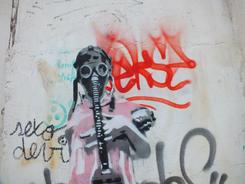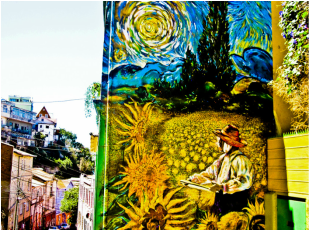PREVIEW OF STYLES AND ARTISTS ON ROUTE...
First of all: Legal or Illegal?
We'd like to point out that we are in favor of any legal or illegal work; from painting a train in it's entirety by holding the train hostage, to getting paid by the city... it all makes up one big scene, and community, no matter what anyone says.
According to the city hall, technically it's mostly illegal. According to those who paint "Who is anyone to determine what's illegal?"
According to the city hall, technically it's mostly illegal. According to those who paint "Who is anyone to determine what's illegal?"
STREET ART & GRAFFITI "Stencil" + "Tag"
The term "street art" is used to define all artistic expressions carried out to get the attention of the public view.
The way we see it, street art is created for the people and passebys, and Graffiti is done for writers by writers... and public view doesn't necessarily matter, as long as you're doing something you love (which is why we don't frown upon tags or throwies). Street art is just art in the streets... no matter how it is done. Graffiti has a certain structure and style, specifically in rectangular or square spaces, and it is mostly letters, and it is born from illegal activities in the 60's and 70's. Read an article about this Cubism & Neo-Cubism Neo-Cubism by Okuda in Valpo
Everyone's heard of Picasso -- He is extremely well known for cubism works.
At some point, people who were moving their graffiti writing to more of an artistic career, decided to look into influential and revolutionary styles of the past, such as picasso's work, and decided to create similar pieces, using their knowledge of spray cans and rollers, and began to paint them in the streets. The outcome, is a wide acceptance on behalf of the community, and cubism is probably found not only in street art, but also in graffiti, due to it's 3D aspect. |
B.R.P. Brigada Ramona Parra
This is a street art style that arose in 1968, and it is linked directly with the communist party of Chile. It started as a simple style of thick outlines and simple colors for Pablo Neruda's UP Campaign, but as artists started joining the "Brigada", the talent level went up, and nowadays they have plenty of murals, in a style that was invented in Chile, which is very common in several areas of Valparaíso.
Fauvism & Neo-Fauvism Street art By Teo (Vida in Gravita Crew)
Fauvism, Fovismo, or Fauvisme, is a style that is well known through Henri Matisse. The people who visit the city enjoy styles like this the most, due to a high use of color and requires a great deal of talent. In Valpo we have various artists who are very talented and are using spray cans, rollers and brushes to create their street art. The outcome is quite successful in getting the viewer's attention.
|
Join us on our street journey through Valparaíso, as we run through styles, take a few pictures, and show you how our walls have become the voice of our city.


